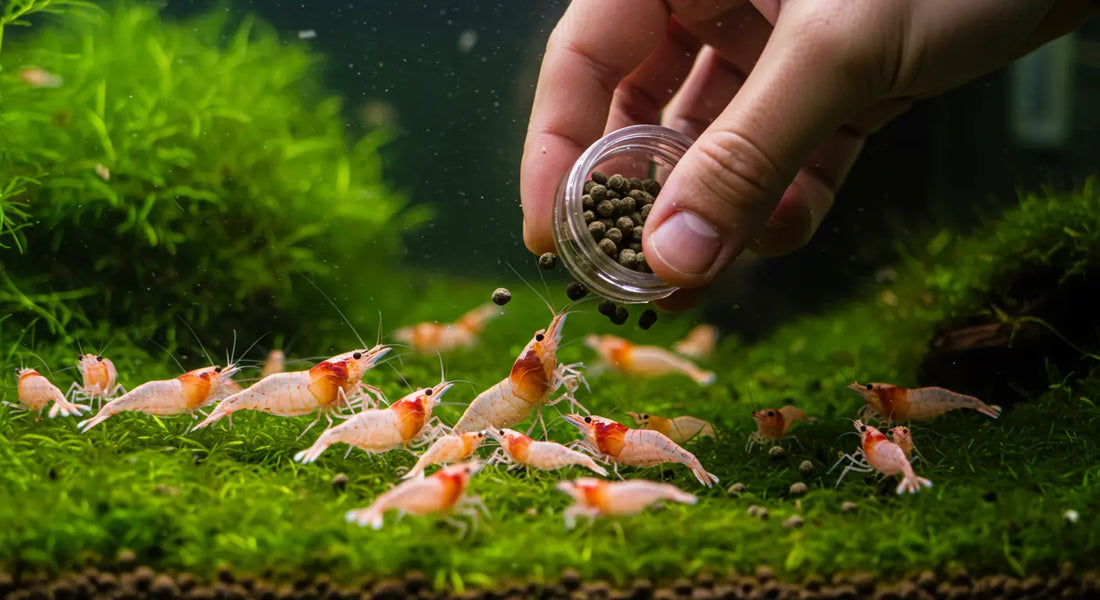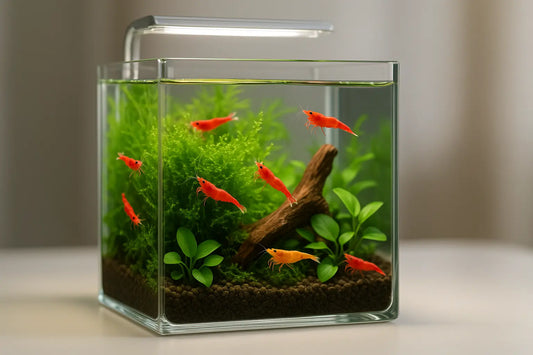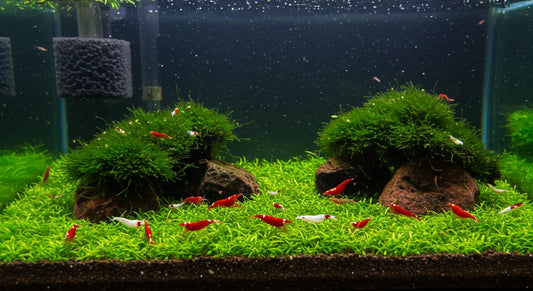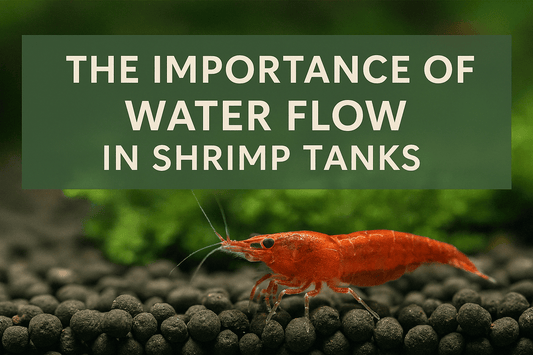
How to Feed Freshwater Shrimp: A Beginner's Guide
Freshwater shrimp are fascinating creatures that play a vital role in maintaining the ecosystem of an aquarium. Their diet isn’t just about keeping them full—it’s the key to their health, vibrant colors, and active behavior.
What Do Shrimp Eat in the Wild?
In their natural habitats, freshwater shrimp graze on biofilm, algae, and decaying organic material. This grazing behavior is crucial to their survival and contributes to the cleanliness of their environment.
Example:
Imagine your shrimp as tiny aquatic gardeners, nibbling on the algae and debris that build up in their surroundings. This natural diet ensures they get a mix of nutrients while maintaining the tank's balance.
Nutritional Requirements for Shrimp
For optimal health, freshwater shrimp need:
- Protein: Supports growth and reproduction.
- Minerals like calcium: Essential for shell development during molting.
- Vitamins: Boosts immunity and overall vitality.
Look for foods like Shrimp Envy Complete Envy, which mimic their natural diet and include nutrient-rich ingredients like spirulina and mulberry leaves.
Types of Food for Freshwater Shrimp
Feeding freshwater shrimp isn't as simple as dropping pellets into the tank. The right food ensures their health while enhancing their vibrant colors. Here are the main types of shrimp food:
1. Commercial Shrimp Foods
High-quality shrimp-specific pellets and flakes are a staple for most aquarists.
Example:
Shrimp Envy Food Fight contains a balanced blend of soy hulls and barley, encouraging natural grazing behaviors while providing essential nutrients.
Pro Tip:
Start with small amounts to observe how much your shrimp consume. This avoids overfeeding and keeps water clean.
2. Natural Food Sources
Supplement their diet with natural foods to mimic their wild grazing habits:
- Algae and Biofilm: Encourage natural growth in your tank by avoiding over-cleaning surfaces.
- Blanched Vegetables: Lightly steamed zucchini or spinach provides a calcium-rich treat.
Example:
Your shrimp will happily nibble on a piece of zucchini for hours, making it an enjoyable sight for hobbyists while benefiting their health.
3. Supplementary Foods
- Indian Almond Leaves: Double as a food source and water conditioner.
- Frozen Bloodworms: A great occasional protein boost, especially for breeding shrimp. We find this to be more popular with neocaridina than caridiina
Make feeding easy by using a feeding dish to avoid food sinking into the substrate, which can lead to water contamination.
Feeding Techniques and Best Practices
Establishing a Feeding Schedule
Shrimp don’t need to be fed daily like fish. Feed them every 1–2 days, ensuring all food is consumed within a few hours.
Example:
If you notice leftover food after feeding, reduce the amount next time. This prevents waste buildup that can harm water quality.
Maintaining Water Quality While Feeding
Feeding your shrimp the right way is just one part of the equation. To keep your shrimp healthy, it's crucial to maintain optimal water quality in your tank. Overfeeding is one of the most common mistakes beginners make, leading to water contamination and stress for your shrimp.
Avoiding Overfeeding
- Start Small: Feed tiny amounts and observe how much is consumed in 1–2 hours. Uneaten food can quickly decay, spiking ammonia levels in the water.
- Use Feeding Tools: A shrimp feeding dish helps contain food in one area, making cleanup easier and preventing debris from spreading across the tank.
Example:
Place a piece of Shrimp Envy Food Fight in the feeding dish and observe. Shrimp tend to flock to the area, making it easy to monitor how much they eat.
Tank Cleanup Best Practices
- Regular Maintenance: Siphon out uneaten food and debris during water changes.
- Promote a Natural Balance: Encourage biofilm and algae growth on tank surfaces as part of the shrimp’s natural food source.
Pro Tip:
Adding live plants like Java moss not only enhances the tank's aesthetic but also provides a surface for biofilm and algae growth, offering additional grazing opportunities.
Troubleshooting Feeding Issues
Shrimp not eating? Here’s what to check:
- Water Parameters: High ammonia, nitrites, or fluctuating pH levels can stress shrimp, reducing their appetite.
- Food Quality: Avoid cheap, low-quality shrimp food that might lack nutrients or contain harmful fillers. Trust brands like Shrimp Envy Complete Envy for quality and balanced nutrition.
- Overfeeding Habits: Uneaten food may make them feel "full" while compromising water quality.
Introducing Shrimp Envy Food Products
Shrimp Envy offers premium, beginner-friendly shrimp food options that meet the unique dietary needs of freshwater shrimp.
Complete Envy Shrimp Food
Features:
- 100% natural ingredients, including spirulina, mulberry, and stinging nettle.
- Supports vibrant coloration and overall health.
How to Use:
Place 1 pellet per 5 shrimp into the feeding dish. Adjust portions based on consumption.
Customer Example:
“A week after switching to Shrimp Envy, I noticed my shrimp’s colors became more vibrant, and they seemed more active during feeding time.” – Anna, Shrimp Keeper.
Food Fight Shrimp Food
Features:
- Includes soy hull and barley, promoting natural grazing behaviors.
- Perfect for small shrimp colonies or beginner tanks.
How to Use:
Drop the recommended amount into the dish. Observe shrimp as they eagerly graze, mimicking their wild feeding habits.
Enhance your shrimp’s diet with trusted products like Shrimp Envy. Shop Shrimp Envy Food Now.
Common Feeding Mistakes to Avoid
Even with the best intentions, beginners can make mistakes when feeding freshwater shrimp. These errors may seem minor but can have a significant impact on shrimp health and tank conditions.
1. Overfeeding
Overfeeding is the most common mistake for beginners. Excess food quickly decomposes, leading to poor water quality, increased ammonia levels, and stressed shrimp.
Solution:
- Always feed in small portions and remove uneaten food after 1–2 hours.
- Use a feeding schedule to prevent accidental overfeeding. For instance, feed every other day rather than daily.
Pro Tip:
If you’re unsure how much to feed, start with one small pellet of Shrimp Envy Complete Envy per 5 shrimp and adjust as needed.
2. Relying on One Food Source
Shrimp thrive on variety. Relying solely on pellets or flakes can result in nutritional deficiencies over time.
Solution:
- Rotate between commercial foods, blanched vegetables, and occasional treats like frozen bloodworms or Indian almond leaves.
- Incorporate high-quality shrimp food like Shrimp Envy Food Fight, which is rich in natural ingredients, alongside fresh options like spinach or zucchini.
3. Ignoring Tank Ecosystem Needs
A clean tank doesn’t always mean a healthy tank. Over-cleaning can strip biofilm and algae, natural food sources for shrimp, leaving them with limited grazing opportunities.
Solution:
- Let algae grow on non-visible surfaces like the back glass or decorations. Shrimp will graze on it naturally.
- Avoid over-cleaning live plants like Java moss, which provide surfaces for biofilm growth.
Example:
One aquarist noticed their shrimp stopped grazing actively after thoroughly scrubbing the tank. Reintroducing algae-covered decor revived their natural feeding habits.
4. Choosing Low-Quality Foods
Cheap shrimp foods often contain fillers and lack essential nutrients, which can lead to poor health and lackluster coloration in shrimp.
Solution:
Invest in premium products like Shrimp Envy Complete Envy, made with natural, nutrient-rich ingredients. These foods not only meet dietary needs but also enhance shrimp colors and activity levels.
Monitoring Shrimp Health and Dietary Adjustments
Regularly observing your shrimp can provide valuable insights into their health and dietary needs. Healthy shrimp are active, have vibrant colors, and molt regularly.
Signs of Healthy Eating Habits
- Grazing on biofilm, algae, or offered food.
- Active swimming and exploring.
- Regular molting with no signs of stress.
Adjusting Diet Based on Shrimp Species
Different species have varying dietary needs:
- Neocaridina shrimp: Thrive on biofilm, algae, and high-protein pellets.
- Amano shrimp: Heavy algae consumers, but benefit from supplementary pellets and vegetables.
- Caridina shrimp: Require soft, mineral-rich foods to support molting.
Pro Tip:
Introduce new foods gradually to see how your shrimp respond. For instance, if switching to Shrimp Envy Food Fight, start with small portions before making it a staple.
Ready to upgrade your shrimp’s diet? Try premium products like Shrimp Envy Complete Envy and see the difference. Shop Shrimp Envy Now.
Conclusion
Feeding freshwater shrimp may seem daunting at first, but with the right knowledge and tools, it’s a rewarding part of maintaining a thriving aquarium. By understanding their dietary needs, choosing high-quality foods like Shrimp Envy, and following proper feeding practices, you’ll ensure your shrimp stay healthy, vibrant, and active.
Key Takeaways
- Feed a balanced diet that includes commercial foods, natural options, and supplements.
- Avoid common mistakes like overfeeding and neglecting the tank’s natural ecosystem.
- Observe your shrimp regularly to adjust their diet based on health, behavior, and species.
Pro Tip:
Start small, monitor their response, and adapt as you learn more about your shrimp’s preferences and needs.
Additional Resources
How to drip acclimate caradina and neocaridina shrimp to your aquarium
- Top 5 Aquarium Supplies Every Shrimp Keeper Needs
- How to drip acclimate caradina and neocaridina shrimp to your aquarium
- Our 3 step Guide to Successful Caridina Shrimp Breeding
Take the guesswork out of shrimp feeding—try Shrimp Envy Complete Envy and Food Fight for a diet that mimics natural feeding habits while providing essential nutrients. Shop Now to start your shrimp on the path to better health and vitality.


